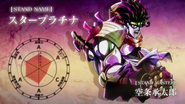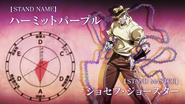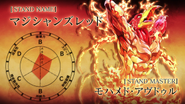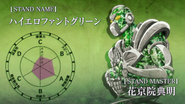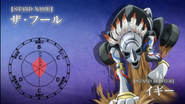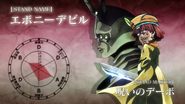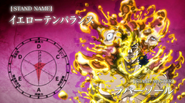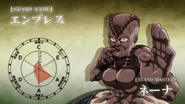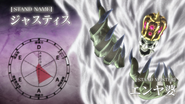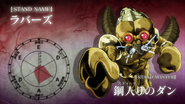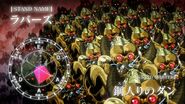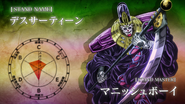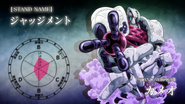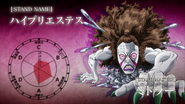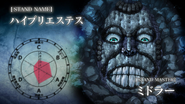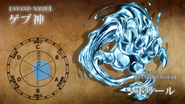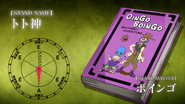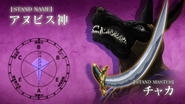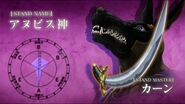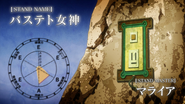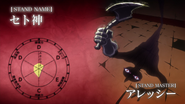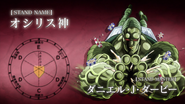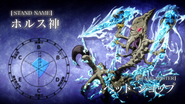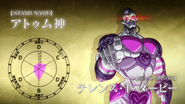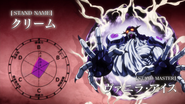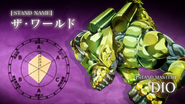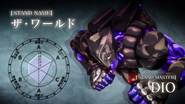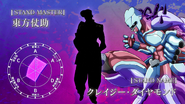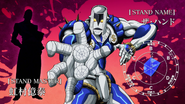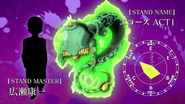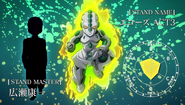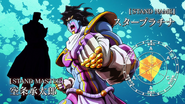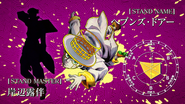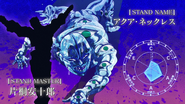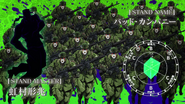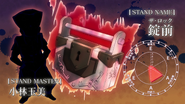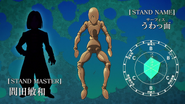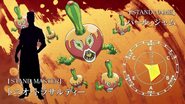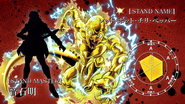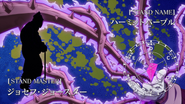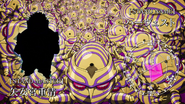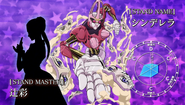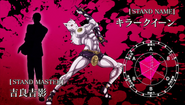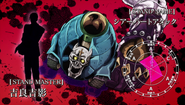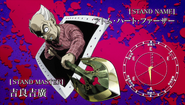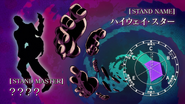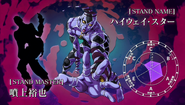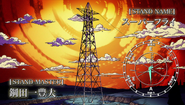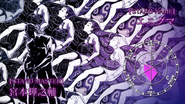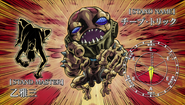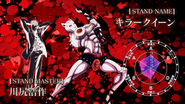- For a complete list of Stands, see List of Stands. For Stands yet to be named, see List of Unnamed Stands.
The Stand (スタンド Sutando) is a supernatural power unique to JoJo's Bizarre Adventure.
A Stand is an entity psychically generated by its proprietor, generally referred to as a Stand User (スタンド使い Sutando Tsukai)[1]. It is viewed as a physical manifestation of the User's fighting spirit. A Stand generally presents itself as a figure hovering near the user and possesses abilities beyond that of an ordinary human, which, depending on the Stand User, can be wielded for good or for evil.
Definition
Stands are defined as personifications of "life energy" whose abilities are given visual form. When first presented, the kana スタンド (Sutando/Stand) in a furigana format is written above the kanji 幽波紋 (Yūhamon),[2] meaning "Ghostly Ripple". However, the attachment to the Ripple has been discarded by Hirohiko Araki early on.
A Stand can also represent the manifestation of an individual's innate "fighting spirit" and embodies, to an extent, the individual's psyche. However, Stands may also derive through the exploration of possibilities and expression of the mind, in which case, only a large amount of mental strength is required.
Beyond that definition, Stands present themselves in a large variety of forms and with different behaviors, if they are sentient at all. They follow a loose set of rules that are regularly broken, and there is no real standard by which one can fully classify Stands. As an embodiment of someone's psyche, Stands are therefore as varied as human minds can be.
Stands in the JoJo universe were first named after the Major Arcana of the Tarot and Ancient Egyptian deities, and often openly attributed some similarity. Near the end of Part 3 and onwards, Stands are commonly named after western musical artists/aliases, bands, albums, and songs. Stands continue to retain an English name format very similar to the tarot Stands.
The User and Their Stand
The Stand is created from someone's psyche, which includes not only humans, but also other living creatures. That individual is referred to as the Stand User. The User then gives their Stand a name and uses it for various purposes.
Unless bound to a specific object or automatic, Stands are attached to their User's body. In that case, any damage the Stand sustains is reflected onto the User's body and vice-versa. Except for rare occasions, when a Stand User dies, their Stand disappears with them. If a Stand suffers so much damage they are destroyed, the User dies as well. However, a User can survive with their Stand destroyed[3] if the Stand is automatic or depending on the level of the User's injury.
Since a Stand incarnates its User's psyche, they share an intimate psychic bond. First and foremost, Stands usually obey their Users' command without question. If a User demands it, the Stand will perform any task within its capacities, which includes attacking someone, defending the User, or any miscellaneous order. In case a Stand is sentient, they can occasionally advise their User that an order is unwise but will carry it on all the same. Secondly, Stands work to protect their users. As is shown when Jotaro tries to shoot himself[4], or when Weather Report tries to commit suicide[5], Stands automatically protect their users from harm, even if it is self-inflicted.
However, there are instances when a Stand cannot be controlled by the User. It can be either automatic like Super Fly or the User can acquire a Stand but not have the fighting spirit to control it like Holy Kujo[6]. In both cases, a Stand can accidentally work against its user's interests through their unsupervised power. However, specifically in the second case, a Stand can go out of control and slowly kill its User like a disease. According to Muhammad Avdol, the User becomes ill, then falls into a coma only to never wake up again; moreover, such occurrences are common enough for him to claim having witnessed many people succumbing to this[6].
Although a Stand generally remains attached to its User, the Stand can sometimes change Users. It can happen if a Stand is somehow stolen from its original User, or if the Stand's ability involves changing User. Thanks to Whitesnake's DISCs, a Stand can change Users but will act to protect its new User instead. Others Stands like Anubis or Cheap Trick will actively try to change Users, and their malevolent nature makes them harm their Users instead of protecting them.
Manipulating a Stand
When a User acquires their Stand, their control over it is partly instinctual but needs practice.
When a User discovers their Stand, they usually do not know anything about it. The User thus has to figure out what their power is; sometimes the power is straightforward and easy to understand like Koichi's Echoes, other times a sentient Stand may explain the power directly to its User as Spice Girl did for Trish Una[7], but sometimes the user will need time to know their Stand's power. For instance, both DIO and Jotaro possessed their Stand for some time until they discovered that they could stop time[8].
Afterward, it is up to the User to discover what their Stand can really do with its ability. A Stand User will need practice to develop their Stand's potential and manipulate it in a more precise manner. Hidden subtleties and applications of the Stand's power may require time for the User to notice. Giorno Giovanna, for example, had to use Gold Experience on Bruno Bucciarati in order to discover what its Life Giving ability did to humans[9], and similarly had to figure out that its abilities could mend wounds[10].
To use a Stand, the User has to consciously summon it. Likewise, to use its power, the User has to command their Stand. Thus, Stand Users are still vulnerable to sneak attacks. This does not apply to automatic Stands which act by themselves.
Acquiring a Stand
- Main article: Bow and Arrow
- Main article: Devil's Palm
In most cases, Stand Users are either born with their Stands or with the potential to unlock one later in life. Without this potential, a person can not achieve a Stand through natural means. For those born with it, the trigger for unlocking one's Stand varies with the user, but is, as mentioned, usually derived through intense mental strength. As such, Stands abilities are typically unleashed during times of stress or conviction. Notable users who acquired a Stand through natural means include Noriaki Kakyoin, Muhammad Avdol, Tonio Trussardi, and Kenzou.
The most widespread way to acquire a Stand is to be pierced by a special Arrow made of an otherwordly meteoric metal. If a person has the potential, they will survive being stabbed and acquire a Stand. Otherwise, the person will die. Notable people who acquired their Stand this way include DIO, Koichi Hirose, Diavolo, and Enrico Pucci. However, if a person is pierced by the Arrow and does not have the potential, but is healed afterwards, they will gain a stand.
Moreover, if someone acquires a Stand this way, their existing descendants and siblings will also gain a Stand, although it may not manifest itself at first or be uncontrollable. In one such case, Jonathan Joestar's body was pierced by the Arrow, causing every living member of the Joestar Family to awaken their own Stands.
In the new continuity of Steel Ball Run and JoJolion, the Arrow doesn't exist. The way most known Stand users have acquired their Stand is unknown. However, one confirmed way of acquiring a Stand is to survive going through a location named the Devil's Palm, a shifting plot of land containing the Saint's Corpse, which can bless someone and give them a Stand.
History of Stands
- Main article: Bow and Arrow
- Main article: Saint Corpse Parts
The "Stands" in JoJo can be conceptualized as a reification of hidden talent, with their source being a sort of energy that's been in the Earth since ancient times.[11] The oldest instance of a Stand User dates back to 16th century with the death of Caravan Serai and the emancipation of his Stand, Anubis.
Appropriately 50,000 years ago, a meteorite crash landed on Earth around an underpopulated region of Cape YorkW, GreenlandW. Several hundred years before the discovery of the virus, a man who wished to acquire the power of gods took the rocks and fashioned them into a set of Arrows whose fate is undetermined.
In 1978, a mineral excavation team discovered the meteorite and uncovered an unknown virus within the rocks of the surrounding area and determined that it has been laying dormant inside the meteorite that hit Earth long ago. Despite extensive research, government doctors were unable to determine the alien virus' purpose outside the total elimination of human life. Akin to the theory of evolution, it was discovered that certain people processed the quality that would allow them to survive when exposed to the virus, rewarding them new abilities[12].
The Arrows resurface in 1986 when an Egyptian ruins investigation team uncovered six of them from underneath the Egypt desert. The arrows were eventually stolen by Diavolo, who sold five of them to Enya the Hag. The arrows allowed the wielder to unlock Stand abilities in those who had the potential to awaken one, essentially acting as the aforementioned trigger. Thus since the 80's, there has a been a sharp rise in the population of Stand users. The six arrows were eventually distributed to various people, among them were Keicho Nijimura, Yoshihiro Kira, Jean Pierre Polnareff, and the Speedwagon Foundation.[13]
Appearance
Stands present themselves in a wide variety of forms. Some adopt an humanoid form, others, the appearance of an object or a tool. These Stands all share an inability to be viewed by ordinary humans. However, Stands bound to a physical object will be visible to humans. In addition, some Stands can simply be devoid of appearance, simply manifesting themselves as a special power.
Stands can be divided into 5 trends based on their appearance. Most of the Stands have features from two or more categories.[14]
| Classification | Summary |
| Natural Humanoid | Stands in this category have physical characteristics similar to human beings, most often their users. Obvious identifiable features include arms and legs, but the category distinctly specifies appendages that are reminiscent of the human muscular system as well as having working eyes and mouth. Stands that apply to this category include Star Platinum, Magician's Red, The World, Crazy Diamond, Heaven's Door, Killer Queen, Gold Experience, Sticky Fingers, Purple Haze, Baby Face, Spice Girl, and Chariot Requiem. |
| Artificial Humanoid | While also having humanoid-like bodies, Stands in this category will often feature artificial or mechanical nuances that separate them from natural humanoids. This includes having completely non-humanoid facial features and mechanical joints. Appearances that resemble robots, cyborgs or androids are applicable here. Examples of Artificial Humanoids include Hierophant Green, Silver Chariot, Ebony Devil, Hanged Man, Lovers, Death Thirteen, Osiris, Cream, The Hand, Bad Company, Cinderella, Echoes, Black Sabbath, Moody Blues, White Album, and Green Day. |
| Natural Non-Humanoid | This category features Stands that, while not human-like, are reminiscent of other lifeforms or objects in nature. This includes basic organisms such as animals and plants, but also more unorthodox concepts such as fog. Stands that may be described as "monsters-like" are often applicable here. Stands in this category include: Hermit Purple, Tower of Gray, Yellow Temperance, Justice, Sun, Horus, Stray Cat, Sex Pistols, The Grateful Dead, Notorious B.I.G., Metallica, and Rolling Stones. |
| Artificial Non-Humanoid | Stands comparable to instruments or mechanical objects are placed in this category. This includes vehicles, weapons, and machines. Stands in this category include Strength, Emperor, Wheel of Fortune, The Fool, Ratt, Aerosmith, and Beach Boy. |
| Other | Stands in this category typically either don't have clear appearances or are integrated into their user's appearance. This includes Stands such as Tohth, Khnum, Tenore Sax, Love Deluxe, Achtung Baby, and Atom Heart Father. |
A Stand's appearance is not set in stone. Stands change appearance as their Users age. As seen with Jean Pierre Polnareff's Silver Chariot[15] or Jobin Higashikata's Speed King[16], a young User has typically child-like Stands and when they become adults, the Stand's features also become adult-like. A special category of Stands that can evolve into different forms, or ACTs, is also able to change form and therefore appearance. Finally, a Stand pierced by the Bow and Arrow can evolve into a brand new form called a Requiem Stand.
Behavior
Most Stands display no personality, sometimes because they do not have a form with which to emote, but the majority of humanoid Stands simply hover behind and above the user awaiting a command. Some Stands display bits of personalities through facial expressions, but it is ambiguous whether the emotions come from the Stand or simply reflect the User's state of mind.
For unknown reasons, a handful of Stands do have a separate consciousness from their Users. They are sentient and can converse with their Users whenever they are summoned. Although they display a variety of personalities, most still obey their Users to the letter. Examples of such Stands include Echoes, Spice Girl, and Whitesnake. Rarely, these Stands are evil and actively threaten other humans with their powers. Anubis and Cheap Trick are examples of such Stands.
Whenever a Stand talks, their otherworldly nature is indicated in the original manga material as a text written with KatakanaW. In the case of audiovisual medias such as the anime or a video game, a Stand's voice will possess a ghostly echo and mechanical tone.
Abilities
- Main article: Stand Types
Each Stand possesses supernatural properties as well as a special, unique power, indirectly granting its User superhuman abilities:
- In general, a Stand is invisible to normal humans, yet can interact with normal objects. It allows the User to use their Stand unnoticed by a large majority of the population. The mundane use of a Stand has been likened to a poltergeist phenomenon by normal people. Even a Stand's power is invisible for ordinary humans; for instance, normal people cannot see Magician's Red's flames, but can feel its heat[17].
- A Stand is invulnerable to any harm except against another Stand. It usually means that the only person capable of defeating a Stand User is another Stand user.
- Stands possess intangibility. It is uncommon but not unheard of for Stand Users to channel their Stands inside their bodies to protect themselves, using their Stand's superhuman durability to their advantage. It is even more uncommon for Stands to phase through objects, but the possibility exists.
- As psychic projections, Users can also communicate through their Stands. Barring rare exceptions, a Stand User typically shares their consciousness with their Stand and is able to see through its eyes. Moreover, a Stand User can also speak through their Stand, enabling a form of distant communication. However, the Stand must have a mouth or otherwise be able to speak to do so.
- Users possess the ability to shrink their Stands to a microscopic level, but the one time it was shown, Polnareff indicated that it was difficult to manipulate the Stand at such a subtle level, and that it was taxing to maintain the small size, making that property impractical in most cases.
Stand Power
Each Stand possesses an esoteric and unique power that defines it and sets it apart from other Stands.
A Stand's power can wildly vary between Stands. The nature of the power can range from relatively mundane powers such as using a sword or controlling flames to extremely powerful ones such as the ability to manipulate the flow of time. These powers have many different subtleties, such as a limited range or a special way of manifesting themselves, that can be exploited during a fight. For instance, Sticky Fingers can create zippers on any surface, but it has to hit an object with its hand to be able to create them. It is up to the User to know how to protect themselves or use their enemy's weakness to their advantage.
Barring rare exceptions, if the Stand is destroyed or the User is knocked out, the Stand's power immediately disappears and any modification to the environment due to its power is reversed.
Each Stand is unique, but many share enough characteristics that they may be grouped under specific Stand Types. Very uncommon Special Stands may appear in the story from time to time due to exceptional circumstances.
Firing Range
One of the most important features of a Stand is its range.
Stands in principle can only be used within a predetermined range centering around the Stand's owner. As such, for the sake of convenience, the range that a Stand can perform abilities is referred to as "Firing Range." A Stand's range and accuracy are inversely proportional; the further the Stand moves away from its firing range, the weaker and less subtle it becomes. This principle is applied to almost all Stands. Furthermore, this can be construed more specifically as "effective" firing range, as a Stand will only gradually lose effectiveness the further it deviates from its firing range, rather than just relinquish immediately. The Stand range is effectively just the range where it can effectively perform[14].
From a general point of view, all Stands can be roughly divided into two types: "Short distance", and "long distance". As a trend, short-range types display great power, many of which excel at direct blows or destruction (Silver Chariot, Crazy Diamond, Sticky Fingers, etc), and are often referred to a "Power Types". Long-range types typically have a special ability that can let them indirectly attack. (Hierophant Green, Echoes ACT1, Beach Boy, etc.)
Some long-distance types are referred to as "Automatic Pilot", in which the "power vs distance from user" principle does not apply. This is exactly what is touched upon in the third Stand theorem, in that autopilot types are typically an extension of an "effect" that results in a Stand triggering. As such, these Stands are independent of the Stand User's will and mental strength, and their power does not drop as a result. As a related note, certain Stand abilities do not have specified ranges (Earth Wind and Fire), an example being time-based powers, such as The World or King Crimson.[14]
Stand Parameters
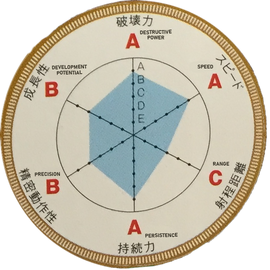
Stand parameters displayed in JOJOVELLER
Stand Parameters (スタンドパラメータ Sutando Paramēta), or Stand Statistics are six statistics used outside of the story to gauge a Stand's capabilities. They are in order (clockwise from top): Destructive Power, Speed, Range, Durability/Staying, Precision, and Developmental Potential/Learning.
- Destructive Power (破壊力 Hakairyoku):
Measures the Stand's strength and ability to cause destruction (physical injury or collateral environmental damage) in a given period of time. Not only limited to brute force, but also to its abilities combined.
- Speed (スピード Supīdo):
Measures the Stand's agility and reflexes as well as performance speed.
- Range (射程距離 Shatei Kyori):
Measures a compromise of the Stand's range of manifestation, range of ability influence, and spatial mobility.
- Durability/Staying (持続力 Jizoku-ryoku):
Measures the Stand's endurance and level of susceptibility to damage and attacks. This category may also gauge the effectiveness of their power's ability of binding toward physical objects.
- Precision (精密動作性 Seimitsu Dōsa-sei):
Measures the Stand's accuracy and range of influence/effect of their abilities to specified targets.
- Development Potential/Learning (成長性 Seichō-sei):
Measures the Stand's possible functions, utilization of its abilities and powers, and capacity to improve its overall capabilities. It decreases in rank as the user masters their Stand. For example, Jotaro Kujo's Star Platinum is Rank A in Developmental Potential during Stardust Crusaders, but is given Rank C during Stone Ocean, as Jotaro has had many years to hone Star Platinum's power. However, Rank C implies that all of Star Platinum's possible abilities and functions still had not been discovered or figured out by that time. For a Stand to gain an E-Ranking, it means that either their Stand user discovered all of their Stand's abilities, or the Stand came with very few abilities and thus cannot grow any more than it has.
Each statistic is ranked from A to E; though rankings of None and Infinite are also possible. Rankings are defined as follows:
- A: Excellent (超スゴイ Chō Sugoi)
- B: Good (スゴイ Sugoi)
- C: Same level as a normal human (人間と同じ Ningen to Onaji)
- D: Weak (ニガテ Nigate)
- E: Very Weak (超ニガテ Chō Nigate)
They are first seen in the artbook JOJO A-GO!GO!, later in canon from Vento Aureo onward as Stands are shown with their parameters along with their name and ability description. Steel Ball Run and JoJolion do not display parameters, but Stands introduced during these arcs are given them in artbooks.
Gallery
In the anime from JoJo's Bizarre Adventure: Stardust Crusaders onward, Stand parameters appear as EyecatchW illustrations displayed after commercials. In JoJo's Bizarre Adventure: Diamond Is Unbreakable, a silhouette of the Stand User is displayed as well.
Stand Parameters are also used in weekly web radio programs like ORAORAdio and Morioh RADIO 4 GREAT to rate the hosts and guests.
Anime (SC)
(Normal)
(Multiple)
(Normal)
(Giant Rock)
(Chaka)
(Khan)
Anime (DU)
Stand Guidelines
The concept of and rules governing Stands have been summarized in the manga on the cover page of Chapter 139,[18] and in an update in the dedicated bonus chapter SBR Extra Chapter 3 (some of the rules showed here may nor come directly from the manga or anime).
- A Stand protects its user, like a guardian. The name comes from "standing by" the user, sometimes using their powers without direct orders in order to protect the user, and by extension, themselves.
- A person can have only one Stand (though their Stand may evolve (e.g. Echoes)).
- Stands can be inherited and if someone gets a Stand, their living descendants also will.
- A Stand is part of its user, and damage is usually reflected between the two. Usually, if a Stand's leg is cut off, its user will lose their leg as well. Certain aspects of some Stands, such as the armor of Silver Chariot, are immune to this effect. If the Stand is not exactly humanoid, they may reflect damage to their user's body relative to the area of the Stand that was damaged, or are an exception.
- In most cases, if the user's leg is chopped off, the Stand will still have both its legs, yet the they won't be able to use it.
- Stands may only be seen by Stand users; the exception being Stands bound to physical objects (e.g. Strength; attached once to a boat).
- A Stand can only be directly damaged by another Stand.
- A Stand's energy or power is inversely proportional to their operating range. The further a Stand is from its user, the weaker it becomes – Long-range Stands and/or Stands' long-range abilities are simpler in mechanism.
- Stands are usually bound to their user's body, but exceptions abound; Wheel of Fortune being bound to a car, and The Fool being bound to sand.
- When a Stand User dies, their Stand typically disappears with them, either slowly fading during a slow death, or visually crumbling and breaking away during a sudden death; however, exceptions do exist, such as Anubis, who stayed in the sword he was bound to, and Stray Cat and Notorious B.I.G., who both only activated after their User's death.
- When a Stand is defeated, their user is either knocked unconscious or killed, depending on the level of injury.
- Stands may, in extreme cases, be hit with such a level of force a crack will spread through them and eventually explode; There is no coming back from this (even with DIO's regeneration) and the Stand will explode.
- No matter the strength of its user, if a stand is destroyed, its user will be too (e.g. DIO).
Trivia
- Hirohiko Araki came up with the idea of Stands when visiting Egypt, when he became overly suspicious thinking everyone there was a bad guy waiting to attack him; likewise his editor at the time believed that an Egyptian theme would be a nice concept.[19]
- Coincidentally, the well-known French pastor Antoine Court de GébelinW believed tarot cards and their divining aspects originated in ancient Egypt. This coincides with several of the original naming aspects of Stands in Part 3.
- When creating Stands, Araki wanted to represent psychic powers in a visual form instead of just drawing objects affected by said powers (like walls being blown off or spoons bending).
- Araki remembers many people being upset when Stands suddenly replaced Ripple within the story and was initially worried that no one would be able to understand them. He thinks the stats sheets helped fans accept the idea better.[20]
- Their basis is very similar to the concepts of thoughtforms, being a manifestation of mental and spiritual energy of an individual into a semi-sentient and existent being.
- In the fifteenth episode of the Diamond Is Unbreakable anime, Heaven's Door's and Rohan's places in the Stand Parameter card are switched, with Heaven's Door placed under Stand Master and Rohan placed under Stand Name.
- The same mistake is made in the next episode with Jotaro and Star Platinum.
- Currently, Stands that don't have an anime version of their Stand parameters are Tenore Sax, Love Deluxe,
Echoes (ACT 2), Achtung Baby, Ratt, and Boy II Man.
References
- ↑ Chapter 139, Yellow Temperance Part 4
- ↑ Chapter 116: Jotaro Kujo (3), pg. 7
- ↑ Chapter 126, Silver Chariot Part 3
- ↑ Chapter 114, Jotaro Kujo Part 1
- ↑ SO Chapter 129, Heavy Weather Part 5
- ↑ 6.0 6.1 Chapter 121, The Power called a "Stand"
- ↑ Chapter 538, Notorious B.I.G. Part 6
- ↑ Chapter 257, DIO's World, Part 11
- ↑ Chapter 445, Bucciarati's Coming Part 3
- ↑ Chapter 504, Baby Face Part 5
- ↑ Hirohiko Araki, 2006
- ↑ Chapter 552: Pronto! On the Line (2) p.13
- ↑ Chapter 569: A Brief Flashback p.13
- ↑ 14.0 14.1 14.2 JOJO A-GO!GO!: STANDS - Standlogy, pp. 84, 103-105, 118-120
- ↑ Chapter 206, "God Sethan" Alessi Part 2
- ↑ JJL Chapter 64, The Plant Appraiser Part 1
- ↑ Chapter 115, Jotaro Kujo Part 2
- ↑ Chapter 139: Yellow Temperance (4)
- ↑ Hirohiko Araki x Kazuma Kaneko Interview
- ↑ 2007 Eureka issue
| Steel Ball Run Stands | |
|---|---|
| Terminology | |||||||||||||||
|---|---|---|---|---|---|---|---|---|---|---|---|---|---|---|---|
| Concepts |
| ||||||||||||||
| Items | |||||||||||||||
c545-553

